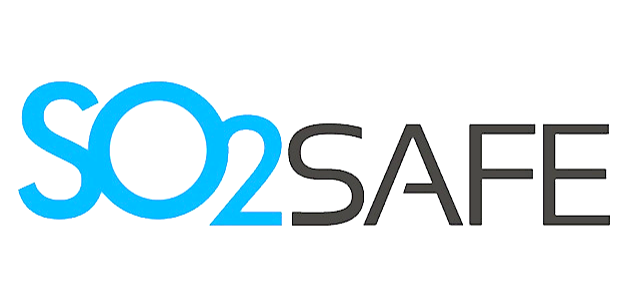
H2020 SO2SAFE Project: Enzymatic SO2 biosensor for rapid food safety monitoring
- Type Project
- Status Filled
- Execution 2015 -2017
- Assigned Budget 743.564,5 €
- Scope Europeo
- Main source of financing Horizon 2020
- Project website SO2SAFE
The main specifications for the development of a miniaturized biosensor for determining sulfite concentration in crustaceans and for the large-scale manufacturing process have been defined. The specifications for materials, processes, subcontractors, and manufacturing conditions have served as initial guidelines for the successful development and manufacture of biosensors.
The novel sulfite biosensors were constructed by modifying the working electrode of SPE with the enzyme sulfite oxidase (SOx). The amount of each component, the working potential, and the analysis time were optimized to achieve maximum sensitivity and stability.
The developed biosensors were applied to:
- The detection of sulfite in crustaceans in a linear range of 40 to 120 mg/kg of sulfite with a stability of 180 days, obtaining good recovery rates for real samples previously analyzed by the official method, Monier Williams.
- Sulfite detection in water within a linear range of 19 to 76 g/L, showing stability for over 180 days. During demonstration activities in Ecuador and Honduras, water samples from shrimp harvesting containers were analyzed and compared with results obtained with the validated BIOFISH 300 benchtop biosensor, yielding equivalent results (10% error).
Validation activities were carried out for the SO2SAFE biosensors using water samples. The results showed that:
- The method is linear.
- Sodium sulfite, sodium metabisulfite, potassium metabisulfite, and formaldehyde metabisulfite, positive interference compounds, are also detected by the biosensor.
- Recoveries ranged from 85 to 115%.
- The SO2SAFE biosensor provided precise and accurate sulfite quantification.
- The LOW was set at 13.62 g/l and the LOD at 4.54 g/l.
A miniaturized measuring device, a portable potentiostat, was designed and developed to read the SPE-based disposable biosensors. Various tests were performed to demonstrate compliance with EU directives on electromagnetic compatibility, confirming that the SO2SAFE device complies with these directives and is eligible for CE marking.
The SO2SAFE biosensor manufacturing design is available and proven, and high manufacturability is achieved for screen-printed electrodes, enzymes, and biofunctionalization and assembly processes.
SO2SAFE's results will be leveraged through the direct marketing of SO2SAFE biosensors through BIOLAN's international sales network and through the development of the SO2SAFE technology platform in other food safety applications, such as the analysis of malic acid in grapes, musts, and wines.
BIOLAN carried out various demonstration and dissemination activities for SO2SAFE results, targeting key stakeholders and the general public. During the SO2SAFE project, BIOLAN attended major international fishing industry trade fairs in Europe, Asia, and Latin America, demonstrated the performance of SO2SAFE biosensors in real-life aquaculture facilities of end-customers, and launched a multimedia communication package including several videos, posters, and a new corporate image. The project results were disseminated through live presentations at various international events organized by the EC, articles in leading international journals, and as an exhibitor at major international aquaculture and seafood trade fairs.
Sulfites are food additives with antioxidant and preservative properties. However, they are registered as allergens by the main international food safety regulatory bodies due to their adverse health effects. Therefore, the maximum concentration of sulfites in food is regulated and must be guaranteed by the agri-food industry. Current methods, such as Monier Williams, do not solve the problem of the high quality control standards required to comply with new regulations on food safety and consumer health protection.
The agri-food industry is demanding new technologies that enable rapid, accurate, and simple methods for monitoring and traceability of sulfite levels throughout the entire supply chain. BIOLAN has already developed a laboratory-scale, simple, reliable, and specific enzymatic biosensor based on solid electrodes for the determination of sulfites.
Within the framework of the SO2SAFE project, BIOLAN has developed a novel, ready-to-use, miniaturized biosensor based on disposable screen-printed electrodes (SPE). This biosensor will enable a highly sensitive, selective, rapid, and easy-to-use method for the determination of sulfites. Furthermore, it has achieved large-scale manufacturing capacity for cost-competitive production.
As a result of this innovative development, BIOLAN offers a complete solution for sulfite level monitoring and traceability (see attached figure). This solution includes:
- BIOFISH 300 for crustacean analysis: This is a benchtop device for laboratory use; it requires calibration before sample analysis. Once calibrated, multiple analyses can be performed; sample analysis takes 3 minutes.
- BIOFISH 700 for crustacean analysis: portable device; requires sample processing. Suitable for installation in laboratories, industries, retail stores, and raw material reception points.
BIOFISH 700 for water analysis: a portable device requiring minimal sample processing. Ideal for field applications for early water monitoring in crustacean processing, SO₂SAFE biosensors consist of an easy-to-use measuring device and bioassays targeted at all agri-food industries where sulfites are used as additives at different stages of the supply chain. This novel solution will be relevant not only to the economics of the food industry but also to society due to the direct impact of sulfites on health.
Sulfites are food additives with antioxidant and preservative properties, but they are registered as allergens by the main international food safety regulatory bodies due to their adverse health effects. Therefore, maximum concentration levels of sulfites in food are regulated and must be guaranteed by the agri-food industry. BIOLAN has developed a simple, reliable, and specific enzymatic biosensor for the determination of sulfites at laboratory scale and has obtained relevant data that support the proposed innovative project.
The main objective of the SO2SAFE project is to develop a novel, ready-to-use, miniaturized biosensor based on disposable screen-printed electrodes for the determination of sulfites in crustaceans, a food type in which sulfite is widely used. This novel solution will have a direct impact not only on the economy of the food industry but also on society due to the direct impact of sulfite on health. Therefore, the SO2SAFE project will also contribute to one of the societal challenges established by the European Commission: food safety and consumer health.
The specific objectives will be:
- To further develop the biosensor prototype to achieve a new, ready-to-use, miniaturized biosensor that enables a highly sensitive, selective, rapid, and easy-to-use method for the determination of sulfites in crustaceans.
- Demonstrate the improved performance of the SO2SAFE miniaturized biosensor to relevant stakeholders
- Expand the biosensor manufacturing process to optimize production costs and increase production capacity.
The SO2SAFE biosensor solution is aimed at all agri-food industries where sulfites are used as additives at different stages of the supply chain. Current methods and tools, widely used for monitoring sulfite levels in the agri-food and crustacean industries, are not addressing the high quality control standards required to comply with new regulations on food safety and consumer health protection.
Progress beyond the state of the art:
In 2016, BIOLAN launched the benchtop biosensor developed for sulfite quantification in crustaceans (BIOFISH 300). At the beginning of the SO2SAFE project, this device was in the prototype phase. Crustacean industries are using this solution; the technology has been very well accepted. It is a very simple method, but it requires calibration and its use is limited to laboratories. Crustacean industries demand a complete solution for sulfite monitoring. The SO2SAFE biosensor (BIOFISH 700) offers critical advantages: pre-calibrated strips or biotests, less than 1 minute to obtain the result, and portability for field application.
Potential impact:
Sulfite monitoring remains a priority for the crustacean industry. Between July 2015 and June 2017, 53 cases of high sulfite concentrations in crustaceans were reported to the Rapid Alert System for Food and Feed (RASFF) portal. Most of the cases were related to contaminated shrimp imported from countries outside Europe, highlighting the importance of monitoring sulfites in raw and processed products, both European and international.
BIOLAN's biosensor-based sulfite quantification solution combines the precision of verification methods such as Monier Williams with the speed and simplicity of in-situ methodologies. This intuitive solution, developed by BIOLAN, enables sulfite monitoring throughout the entire shrimp production process, reducing the risk of contamination with high sulfite concentrations.
- BIOLAN MICROBIOSENSORES SL







